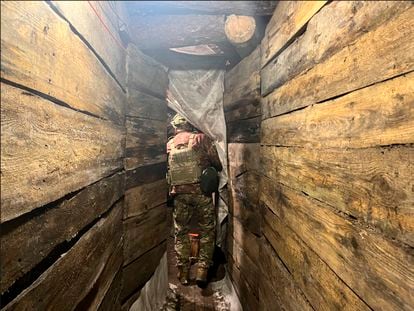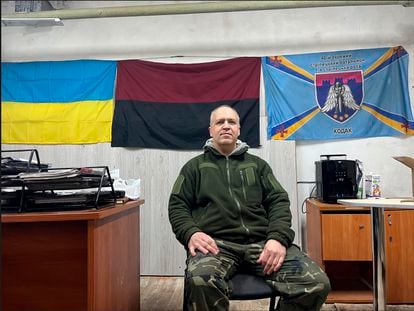Commander Nafania advances through the snowy forest at a steady pace. Just two years ago, this miner with a narrow smile, born in the central region of Dnipropetrovsk, did not imagine himself like this, with a rifle on his shoulder, in a frozen trench on the eastern front of Kupiansk, with a brigade made up of other miners, bosses warehouse workers, workers, a store manager, drivers, a financial analyst… All of them converted into soldiers, enduring one of the hottest spots on the more than 1,200 kilometer battle front line of Russia's war against Ukraine. Nafania, the war badge of the man in command of the 40th Separate Rifle Brigade (Kodak), marks a gap in the ground where the trees whiten. And another beyond. “They are remains of the Russians. This area was occupied, now they want to go back,” he mutters. A buzzing sound precedes the explosion of a missile. The rain of artillery thunders. The Russian positions are less than two kilometers away. The Kremlin wants to surround the entire area and gives no rest.
Russia has increased the offensive on the Kupiansk bastion, about 40 kilometers from the border with Russia, a city that it took with little effort in the first days of the invasion and that the Ukrainian army recovered in September 2022. Moscow used the town, of about 60,000 inhabitants before the invasion, and the rest of the area as an important logistics center. Now he wants to capture it again and use it as leverage to take over the entire Lugansk region (which he already maintains almost completely occupied) and march from there towards the north of the Donetsk region. It also seeks to use it to advance toward Kharkiv—before the war, the second most populous city in Ukraine—and achieve a better approach to punishing that town that Russian President Vladimir Putin coveted from the first moments of the attacks and that in In recent days it has been busy hitting with storms of missiles and drones.
Russian troops are focusing one of their main war efforts on the Kupiansk front, according to analysts. Chechen special forces and several Russian motorized rifle units operate along the entire line to the occupied city of Kremina. Moscow is now also preparing to reinforce its push with up to 5,000 more men, several Ukrainian military observers explain. Russia has advanced a few meters—“marginal,” experts say—since it launched the offensive again last October to also try to distract Ukrainian troops from the counteroffensive to the south, which has ended up failing.
“They launch constant assaults, they try to advance and if their companions fall they don't even return to collect their bodies,” says Nafania. “I still can't understand what his motivation is,” says the 34-year-old soldier, nicknamed after the character from a Soviet-era animated film. The 40th Separate Rifle Brigade, formed as territorial defense forces in the early stages of the invasion, was integrated into the Ukrainian army and now remains alongside others in the area, dotted with villages and forests and surrounded by labyrinths of trenches.
Two years later, Putin maintains his goal of subduing Ukraine. “He wants to occupy the entire country, and has launched a major operation to take Donbas, in the east,” says Mijailo Samus, a renowned Ukrainian military analyst. “He is trying to make his way in different directions from the north, the east and the south at the same time,” he explains by phone. Samus doubts the strategic importance of Kupiansk and the entire area to Moscow. “They occupied that area for six months and it was of no use; Also, if they only succeed in one direction it doesn't matter. From an operational point of view it is absurd,” adds the expert, who describes the intense assaults launched by Russian troops to advance on the Kupiansk front with mortars, all types of artillery, drones and armed vehicles.
Join EL PAÍS to follow all the news and read without limits.
Subscribe
For kyiv's forces, meanwhile, advancing in that now frozen area would open an interesting door to recover Lugansk. Furthermore, in the case of going back many meters, regaining them later would be much more complicated. But for now, with difficult terrain, lack of ammunition, overloaded weapons and the need for reinforcements, Ukrainian troops are struggling to hold the line.

MARÍA SAHUQUILLO
electromagnetic warfare
Back at the 40th Separate Rifle Brigade outpost, it's time for lunch. One of the several Dmitris, the cook on duty, has made borscht, a Ukrainian beet soup that warms the body after guarding through the snowy trenches. Another Dmitri, a former financial analyst, checks the equipment of a drone and consults on his laptop. He is one of those in charge of the technical part of the unmanned aircraft that the brigade has incorporated, and which have proven essential for the battle. Especially with such diminished arsenals in which ammunition is scarce. Dmitri, now the technician, says that he has managed to detect and repair a flaw that allowed Russian troops to attract drones and seize them through electromagnetic warfare tools, which the Kremlin deploys to try to counteract the proliferation of unmanned aircraft. in the Ukrainian brigades.
Many of the soldiers of the 40th had never been to the east of the country, explains a third Dmitri, alias Doc, an electronics specialist who always wanted to be a doctor. Most of them are from the regions of Zaporizhia, in the south, or Dnipropetrovsk, in the center of the country. “In 2014, when the war in Donbas started, I thought it was far away, that it wasn't something that affected me,” he says slowly. “I didn't do anything, I didn't go anywhere. Now I think I should have done more. So when they started bombing our cities on February 24, 2022, I signed up,” he says. And there he is, alternating his time between the outpost and the trench in the snow. When he can, he draws landscapes, churches, his children, his country house. He shows the drawings of him on the mobile screen. He is a good painter. “This helps a lot for morale, to disconnect the mind,” he confesses, shrugging his shoulders.
Nafania and the three Dmitris have not been home for months. There is no replacement. Most of those who are not already in trenches like that, where they have had a large infestation of mice that still sneak around the three cats that live with the brigade, have lost their sense of existential urgency. They don't want to go to war. Ukraine is now divided into two: that of the battle fronts – trenches with mud, snow and mice under the rain of Russian artillery – and that which is experiencing a new normality, altered from time to time by new bombings. Maybe three Ukraines, with the areas occupied by the Kremlin. Troops and citizens are exhausted everywhere.

But as the invaded country enters its third year of war, with an extremely challenging 2024 in which many doubt whether Western support will hold, others in the snowy forest of Kupiansk remember that Russia expected to travel hundreds of kilometers across Ukraine and succeed in a few days. That February 2022, Russian military commanders had asked officers to pack their dress uniforms, which they hoped to wear in victory parades in kyiv. Nothing went as Putin expected. Almost 700 days have passed and Russia maintains 20% of the Ukrainian territory occupied and is pushing to conquer Donbas and the south, while bleeding its country dry.
With the latest airstrikes on major Ukrainian cities, from Kharkiv in the east to Kiev, the capital, or even Lviv in the west, Putin is trying not only to deplete Ukraine's stockpile of air defense material. He also wants the world to forget that Russia faces the greatest human and strategic catastrophe since the collapse of the Soviet Union. And he tries to play the patience card by believing that his allies will eventually get tired and leave Ukraine alone.
Evening falls on the Kupiansk front and dense clouds emerge in the sky. The drones that Russia deploys to monitor and attack have less visibility. Artillery rain continues. “This is hard, it's difficult, but I'm glad I can be here to ensure our future,” says Doc. “Further away, maybe they don't feel the war like they do in the trenches, but that's because we are here. “If we retreated, everyone would be on their knees.”
Follow all the international information on Facebook and xor in our weekly newsletter.
Subscribe to continue reading
Read without limits
_
#Ukrainian #resistance #Russia #frozen #trenches #Kupiansk #launch #constant #assaults
